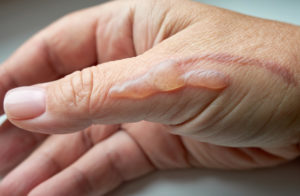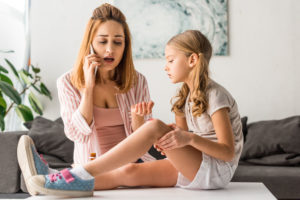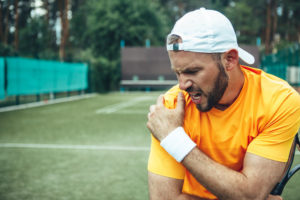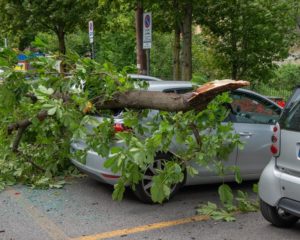Monday, January 10th, 2022
 Accidents happen, and burns are an injury that can happen in the blink of an eye. Whether you accidentally grab a hot pan or spend too much time out in the sun, a burn can cause serious pain.
Accidents happen, and burns are an injury that can happen in the blink of an eye. Whether you accidentally grab a hot pan or spend too much time out in the sun, a burn can cause serious pain.
Burns range in severity and are classified as either a first-degree, second-degree, or third-degree burn. To ensure that it heals properly, it’s important to know when you need to seek medical care for a burn. Here, we’ll explore this topic so that you can receive the care that you need for future injuries.
Factors to Consider Before Seeking Medical Care for a Burn
To determine what kind of care that you need for a burn, consider these factors:
The Depth of the Burn
Burns are classified by depth. First-degree burns affect the epidermis, which is the outer layer of the skin. Second-degree burns reach the epidermis and part of the dermis, which is the lower layer of the skin. Third-degree burns go through both the epidermis and the dermis, and may reach the next layer of the skin, the subcutaneous tissue.
While first-degree burns can often heal with at-home treatment alone, second and third-degree burns require immediate medical care. If the burn is third-degree or worse, the patient generally will need to go to the emergency room.
The Size of the Burn
The size of the burn, meaning how much of the skin it spreads across, is also a factor to consider. Burns that are large and/or spread across a significant portion of the skin are often more dangerous. If the burn is bigger than the size of your hand, you should head to the ER.
The Location of the Burn
Some parts of the body are more likely to become infected than others, including the hands, feet, face, and genitals. This also makes burns in these areas more difficult to treat. Burns that extend all of the way around a limb, toe, finger, or over a joint may also require more extensive medical care. In any of these cases, you should seek out medical care for the burn.
At Suncoast Urgent Care, we offer immediate care for burns. Contact us today to schedule an appointment!
Thursday, July 15th, 2021
 If you’ve sustained an injury, your best option is to promptly visit a medical professional and receive a diagnosis. Diagnosing yourself is unreliable and may lead to further injury. That being said, knowing the difference between a sprain and a fracture can be helpful in better understanding the terminology used by your doctor.
If you’ve sustained an injury, your best option is to promptly visit a medical professional and receive a diagnosis. Diagnosing yourself is unreliable and may lead to further injury. That being said, knowing the difference between a sprain and a fracture can be helpful in better understanding the terminology used by your doctor.
Sprains
A sprain occurs when a ligament surrounding the joint is stretched or torn. Sprains range from Grade 1 to Grade 3. A Grade 1 sprain occurs when a ligament is only stretched, a Grade 2 sprain occurs when the ligament is incompletely torn, and a Grade 3 sprain occurs when the ligament is torn or completely separates from a joint. (more…)
Saturday, March 20th, 2021
 Unfortunately, car accidents are common, especially here in Florida. Approximately 20,000 car accidents are reported by the Florida Highway Safety and Motor Vehicles Department every year, making the risk of an accident high for all motorists, passengers, bikers, and pedestrians on the road.
Unfortunately, car accidents are common, especially here in Florida. Approximately 20,000 car accidents are reported by the Florida Highway Safety and Motor Vehicles Department every year, making the risk of an accident high for all motorists, passengers, bikers, and pedestrians on the road.
If you’re in an auto accident, it’s essential to see a doctor promptly. Many different types of injuries may occur after an accident, not all of which will show immediate symptoms. To ensure that all injuries are diagnosed and treated as soon as possible, you’ll need to visit a doctor, such as one of the experienced physicians here at Suncoast Urgent Care. (more…)
Tuesday, December 15th, 2020
 Do you know how to tell if your child needs stitches or not? Most parents are clueless about how severe an injury needs to be to worry about immediate care. Most of the time, wounds are going to close well on their own, especially if it is a straight laceration. However, sometimes you will need an expert opinion, and perhaps a few stitches as well. Here are some signs your child might need stitches and should be seen.
Do you know how to tell if your child needs stitches or not? Most parents are clueless about how severe an injury needs to be to worry about immediate care. Most of the time, wounds are going to close well on their own, especially if it is a straight laceration. However, sometimes you will need an expert opinion, and perhaps a few stitches as well. Here are some signs your child might need stitches and should be seen.
Deepness of the cut
Even if a cut isn’t large, a deep cut is more prone to infection. It may be best to get stitches to reduce the risk. (more…)
Tuesday, September 15th, 2020
 Did you know that the shoulder is the most often injured part of the body? We see many shoulder dislocations every year, and we are happy to treat them so that you can avoid the ER or walk-in clinics when your doctor is unavailable. Here are some signs that your shoulder has dislocated and what you should do.
Did you know that the shoulder is the most often injured part of the body? We see many shoulder dislocations every year, and we are happy to treat them so that you can avoid the ER or walk-in clinics when your doctor is unavailable. Here are some signs that your shoulder has dislocated and what you should do.
How do you know it’s dislocated?
You can certainly injure your shoulder without dislocating it, and you may not need prompt medical attention for every shoulder injury. However, if it is dislocated, you should seek medical attention as soon as you are able.
Your shoulder might not look dislocated and if that is the case, you may think that it is a minor injury, but shoulder dislocation can also look like: (more…)
Monday, June 15th, 2020
 Kids play hard. Only first time parents think that they can protect their children from every potential danger or injury. Soon, even these parents come to realize that children will get hurt from time to time, no matter how careful they are. It is important to be prepared to handle minor injuries, scrapes, and bruises with more than just a kiss on the boo-boo. Here are some basic first aid tips for burns.
Kids play hard. Only first time parents think that they can protect their children from every potential danger or injury. Soon, even these parents come to realize that children will get hurt from time to time, no matter how careful they are. It is important to be prepared to handle minor injuries, scrapes, and bruises with more than just a kiss on the boo-boo. Here are some basic first aid tips for burns.
You’d think kids would be nowhere near a fire, but there are a lot of opportunities for your little one to get burned. They could try to help in the kitchen and have an accident, they could be baking alone for the first time and forget to use an oven mitt, or they might get too close to a campfire before anyone can catch them. (more…)
Wednesday, April 15th, 2020
Spring storms can often weaken tree limbs or cause dead trees to fall. This can be very hazardous, and some injuries could be serious. If you have a tree limb fall on you or someone else in your yard, you will likely need to seek medical attention. Here’s what you should do.
Carefully Remove the Tree Limb
The first priority is to free the person from the tree limb. Lift the limb and slide it over to the side carefully, trying not to bump or jar the person. If the tree limb is too large to lift, you may need to call for help.
(more…)
Saturday, February 15th, 2020
The winter was cool and breezy, and the children didn’t have as much time to play outdoors as they do the rest of the year. But soon spring will be upon us, and children everywhere will be begging to play outside every minute of daylight.
You can’t be there for your child the entire time they are outside. There is no way to keep them from getting hurt from time to time, and every child gets bumps, bruises, and scrapes that need nothing more than some basic first aid, sometimes more than once a day.
(more…)
Wednesday, January 15th, 2020
Although Florida doesn’t get the winter weather that other states see, there are still potential hazards in the wintertime that you should avoid for your health and wellbeing. While they are rare, winter weather storms can happen in Florida. It is important to know how to cope with these storms and what to do when an injury does occur.
Stay Indoors
Most Floridians are woefully unable to cope with a winter storm. Many people in Florida do not own a heavy coat unless they frequently travel to colder climates. To keep yourself healthy and safe, the Department of Health recommends that during cold weather snaps and storms that you stay indoors as much as possible.
If you do venture outside, make sure that you are bundled up to avoid becoming ill from exposure to the cold. You should also make sure that you are careful on any slippery spots on sidewalks and drives, which can happen if temperatures dip below freezing after a rainstorm. If you do have a fall, make sure that you seek medical treatment right away to make sure that you don’t injure yourself further.
Don’t Wait to Seek Treatment
If you or a loved one are injured during the winter or at any other time, it is a good idea to get checked out by a doctor as soon as possible. Even if you think your injury is minor, if you are unable to put pressure or weight on the affected limb, you should get it checked out just to make sure that a more serious injury has not occurred. You may also need stabilizing treatment, such as a brace, wrap, or even cast.
If you or a loved one become injured this winter, contact us immediately for an appointment or walk into our urgent care clinic.
Sunday, December 15th, 2019
There are many different situations in which something might fall on your arm, hand, foot, or leg. There are many more instances in which you might injure these limbs because of a fall. It is important that you know what to do in these situations so that you don’t injure yourself further. Here are some tips.
Avoid Weight
If you have injured a limb, you should avoid lifting or putting weight on it until you are certain that you have not caused a serious injury, such as a break. If you injure your foot, ankle, or leg, you should avoid putting weight on it. If you injure an arm, elbow, wrist, or hand, you should not lift anything heavier than a cup while you are recovering.
(more…)
 Accidents happen, and burns are an injury that can happen in the blink of an eye. Whether you accidentally grab a hot pan or spend too much time out in the sun, a burn can cause serious pain.
Accidents happen, and burns are an injury that can happen in the blink of an eye. Whether you accidentally grab a hot pan or spend too much time out in the sun, a burn can cause serious pain. 
 If you’ve sustained an injury, your best option is to promptly visit a medical professional and receive a diagnosis. Diagnosing yourself is unreliable and may lead to further injury. That being said, knowing the difference between a sprain and a fracture can be helpful in better understanding the terminology used by your doctor.
If you’ve sustained an injury, your best option is to promptly visit a medical professional and receive a diagnosis. Diagnosing yourself is unreliable and may lead to further injury. That being said, knowing the difference between a sprain and a fracture can be helpful in better understanding the terminology used by your doctor.  Unfortunately, car accidents are common, especially here in Florida. Approximately 20,000 car accidents are reported by the Florida Highway Safety and Motor Vehicles Department every year, making the risk of an accident high for all motorists, passengers, bikers, and pedestrians on the road.
Unfortunately, car accidents are common, especially here in Florida. Approximately 20,000 car accidents are reported by the Florida Highway Safety and Motor Vehicles Department every year, making the risk of an accident high for all motorists, passengers, bikers, and pedestrians on the road. Do you know how to tell if your child needs stitches or not? Most parents are clueless about how severe an injury needs to be to worry about immediate care. Most of the time, wounds are going to close well on their own, especially if it is a straight laceration. However, sometimes you will need an expert opinion, and perhaps a few stitches as well. Here are some signs your child might need stitches and should be seen.
Do you know how to tell if your child needs stitches or not? Most parents are clueless about how severe an injury needs to be to worry about immediate care. Most of the time, wounds are going to close well on their own, especially if it is a straight laceration. However, sometimes you will need an expert opinion, and perhaps a few stitches as well. Here are some signs your child might need stitches and should be seen. Did you know that the shoulder is the most often injured part of the body? We see many shoulder dislocations every year, and we are happy to treat them so that you can avoid the ER or walk-in clinics when your doctor is unavailable. Here are some signs that your shoulder has dislocated and what you should do.
Did you know that the shoulder is the most often injured part of the body? We see many shoulder dislocations every year, and we are happy to treat them so that you can avoid the ER or walk-in clinics when your doctor is unavailable. Here are some signs that your shoulder has dislocated and what you should do. Kids play hard. Only first time parents think that they can protect their children from every potential danger or injury. Soon, even these parents come to realize that children will get hurt from time to time, no matter how careful they are. It is important to be prepared to handle minor injuries, scrapes, and bruises with more than just a kiss on the boo-boo. Here are some basic first aid tips for burns.
Kids play hard. Only first time parents think that they can protect their children from every potential danger or injury. Soon, even these parents come to realize that children will get hurt from time to time, no matter how careful they are. It is important to be prepared to handle minor injuries, scrapes, and bruises with more than just a kiss on the boo-boo. Here are some basic first aid tips for burns.


